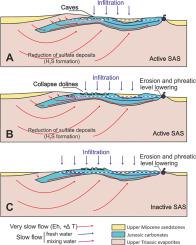Geomorphology ( IF 3.1 ) Pub Date : 2021-07-22 , DOI: 10.1016/j.geomorph.2021.107866 Antonio González-Ramón 1 , Antonio Pedrera 2 , Sergio Martos-Rosillo 1 , Concepción Jiménez de Cisneros 3 , Ana Ruiz-Constán 1 , Fernando Gázquez 4, 5

|
We investigated speleogenetical processes and the formation of unusual endo- and exokarstic features within carbonates rocks in the Sierra de Mollina mountain range (southern Spain), a sector affected by salt tectonics. Allochthonous Triassic evaporites partially overlie younger subsalt Jurassic limestones and dolostones. The carbonate beds show signs of karstification, including large collapse structures and a dense field of collapse sinkholes. We focus our study on the two deepest cavities (~100 m deep), namely Sima del Soldado and Órganos Cave, where significant secondary gypsum (CaSO4·2H2O) and traces of mineralogical associations (alunite, jarosite, barite and others) have been reported. We analyzed the sulfur (δ34S) and oxygen (δ18O) of the gypsum sulfate and the δ18O and δD of its structural water. Our results suggest that reduction of sulfates from the Upper Triassic evaporites generated hydrogen sulfide (H2S). Subsequently, sulfuric acid (H2SO4) was generated in oxic conditions, which triggered sulfuric acid speleogenesis (SAS). Our reconstruction of the isotopic composition of the paleo-aquifer using stable isotopes of gypsum hydration water (δ18O and δD) indicates that gypsum crystallized in a climatic setting colder than present. Gypsum precipitation included acid replacement of the carbonates and hydration of anhydrite (CaSO4) generated in previous stages. The overlying Triassic evaporites provided the hydraulic gradient needed to drive sulfate-rich water towards the deeper, O2-depleted carbonate aquifer. Sulfate reduction in anoxic conditions generated H2S that later mixed with O2-enriched waters in the upper carbonate aquifer, creating the sulfuric acid necessary for SAS. The stable isotopes of gypsum from Órganos Cave reveal that the vadose zone was not connected to the surface, probably being confined beneath Triassic evaporitic rocks, while the Sima del Soldado underwent a partial connection with atmospheric O2.
中文翻译:

部分被蒸发岩覆盖的碳酸盐岩中硫酸成穴演化的限制(Sierra de Mollina,西班牙南部)
我们研究了洞穴形成过程以及在 Sierra de Mollina 山脉(西班牙南部)的碳酸盐岩中形成异常的内岩和外岩特征,该山脉受盐构造影响。外来三叠纪蒸发岩部分覆盖在较年轻的盐下侏罗纪灰岩和白云岩上。碳酸盐岩床显示出岩溶的迹象,包括大型坍塌结构和密集的坍塌落水洞。我们将研究重点放在两个最深的洞穴(~100 m 深)上,即 Sima del Soldado 和 Órganos 洞穴,那里有大量的次生石膏(CaSO 4 ·2H 2 O)和矿物协会的痕迹(明矾石、黄钾长石、重晶石等)已经汇报过。我们分析了硫 (δ 34 S) 和氧 (δ 18O) 的硫酸石膏及其结构水的 δ 18 O 和 δD。我们的结果表明,上三叠统蒸发岩中硫酸盐的还原生成了硫化氢 (H 2 S)。随后,在有氧条件下生成硫酸 (H 2 SO 4 ),从而引发硫酸成穴 (SAS)。我们使用石膏水合水的稳定同位素(δ 18 O 和 δD)重建古含水层的同位素组成表明,石膏在比现在更冷的气候环境中结晶。石膏沉淀包括碳酸盐的酸置换和硬石膏 (CaSO 4) 在前一阶段生成。覆三叠纪的蒸发提供驱动富含硫酸盐的水朝着更深,O-所需的水力梯度2贫碳酸盐的含水层。在缺氧条件下硫酸盐还原生成 H 2 S,然后与上部碳酸盐含水层中富含O 2 的水混合,产生 SAS 所需的硫酸。Órganos 洞穴石膏的稳定同位素表明,包气带没有与地表相连,可能被限制在三叠纪蒸发岩之下,而 Sima del Soldado 部分与大气中的 O 2相连。











































 京公网安备 11010802027423号
京公网安备 11010802027423号